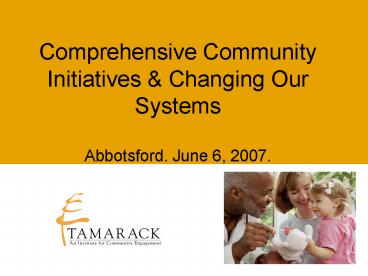Background - PowerPoint PPT Presentation
1 / 38
Title:
Background
Description:
Tamarack is a charitable organization dedicated to helping citizens build ... Health systems under siege. Marginalization of entire parts of the community ... – PowerPoint PPT presentation
Number of Views:28
Avg rating:3.0/5.0
Title: Background
1
Comprehensive Community Initiatives Changing
Our SystemsAbbotsford. June 6, 2007.
2
- Tamarack is a charitable organization dedicated
to helping citizens build prosperous and healthy
communities. - Through its Learning Centre, Tamarack works with
its partners to build on their experience and
develop practical tools, resources and learning
techniques that can strengthen local efforts to
address community issues. - For more information on Tamarack, see the
organizations website at www.tamarackcommunity.ca
.
3
Communities Taking Care of Themselves Throughout
History
4
Slipping Stalled on OurQuality of Life
- Widening income gaps
- Increase in gang and youth violence
- Brittle ecosystems
- Health systems under siege
- Marginalization of entire parts of the community
5
The Dark Side of the Parking Lot
6
You don't see something until you have the right
metaphor to let you perceive it. Thomas
Kuhn Believing is seeing. Karl Weick
7
Complex Issues
8
Types of Community IssuesThe Stacey Matrix
Far from
Agreement
Close to
Far from
Certainty
Close to
9
Simple
Far from
Agreement
Simple Recipe
Close to
Far from
Certainty
Close to
10
Technically Complicated
Far from
Agreement
Technically Complicated Expertise, Knowledge,
Relationships
Simple
Close to
Far from
Certainty
Close to
11
Socially Complicated
Far from
Socially Complicated Relationships, Power
Agreement
Simple Plan, control
Technically Complicated
Close to
Far from
Certainty
Close to
12
The Zone of Complexity
Far from
Zone of Complexity
Socially Complicated
Agreement
Technically Complicated
Simple
Close to
Far from
Certainty
Close to
13
Eight Features of Complex Issues
- Multiple inter-related root causes
- Multiple stakeholders
- Difficult to frame
- Emergent, adaptive, unpredictable
- Unique
- Paradoxes dilemmas
- Difficult to eliminate
- Long-term in nature
14
Chaos
Chaos Massive Avoidance
Far from
Socially Complicated
Zone of Complexity
Agreement
Technically Complicated
Simple
Close to
Far from
Certainty
Close to
15
"Stop trying to change reality by attempting to
eliminate complexity. David Whyte
16
Some Implications
17
- From Physics Envy To Biology Envy
18
Organizing for Complexity
- Complexity
- Difficult to frame
- Multiple root causes
- Multiple stakeholders
- Emergent
- Unique
- Paradoxes, dilemmas
- Difficult to eliminate
- Long term nature
- Emerging Response
- Good enough framing
- Cross boundary comprehensive
- Collaborative flat
- Adaptive learning
- Customized responses
- Transparent coping
- Moving the needle
- Incremental changes
19
Changes in the Way We Work
- Leadership Management
- Governance Accountability
- Planning Implementation
- Policy Design Administration
- Learning Evaluation
- Community Investment
- Communication
- Community Mobilization Organizing
20
Question
- What are some of things we need to do to
effectively plan and implement an effort to move
the needle on complex issues?
Stay in Table Groups
21
(No Transcript)
22
(No Transcript)
23
Planning ImplementationTwo Approaches
24
A Framework for Ending Homelessness in Red Deer
Upstream
Downstream
Homeless
At Risk
At Risk
Healthy Community (Primary)
Systems Prevention (Secondary)
Emergency Prevention (Tertiary)
Rapid Re- Housing
Follow up Support
Emergency Shelter
Tool Kit for Relationship Development -- gt
Personal Capacity Strategic Areas to build
Capacities and Accessibility Education,
Housing, Relationship, Employment, Training
Income, Health Care Methods Public Education
Awareness, Outreach, Strategic Data,
Infrastructure, Policy and Advocacy Evaluation
Looks Intergenerational, Positive for Community,
Positive for the Individuals Affected
25
Living Portfolio of Strategies
Strategy Research Selection Process
The Living Portfolio
Initial Pool of Strategies
26
Question
- What are some of things we need to do to
effectively evaluate our efforts to move the
needle on complex issues?
Stay in Table Groups
27
Complex Environment
28
Intervention
Insert action into the system
29
Unpredictable Outcomes
EMERGENCE
30
Evaluation Approaches
31
Emerging Methodologies
32
Opportunities Niagara
- Testing the contribution of various organizations
involved in a collaboration to launch a housing
project.
33
Moving Forward
34
Jane Jacobs
- The sign of a healthy community is one that
self-corrects when the institutions and
responses that worked in the past no longer suit
new circumstances.
35
Meg Wheatley
- While self-organization calls us to very
different ideas and forms of organizing, how else
can we create the resilient, intelligent, fast,
and flexible organizations and communities that
we require? How else can we succeed in organizing
in the accelerated pace of our times except by
realizing that organizations and communities are
living systems? - This is not an easy shift, changing ones model
of the way that world organizes It is work that
will occupy most of us for the rest of our
careers. But the future pulls us toward these new
understandings with an insistent and compelling
call.
36
Robert Putnam
- Our job now is not to blame. It is to create.
37
Discussion
- Does this way of describing complex issues,
collaboration and comprehensiveness change the
way think about the work? If so, how? - What new questions emerge?
- What are the implications of viewing the work
this way?
38
Comprehensive Community Initiatives Changing
Our SystemsAbbotsford. June 6, 2007.































